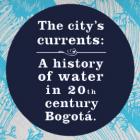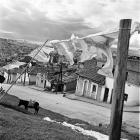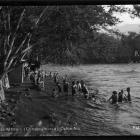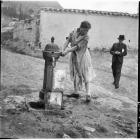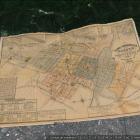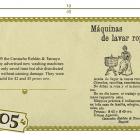Water supply and consumption
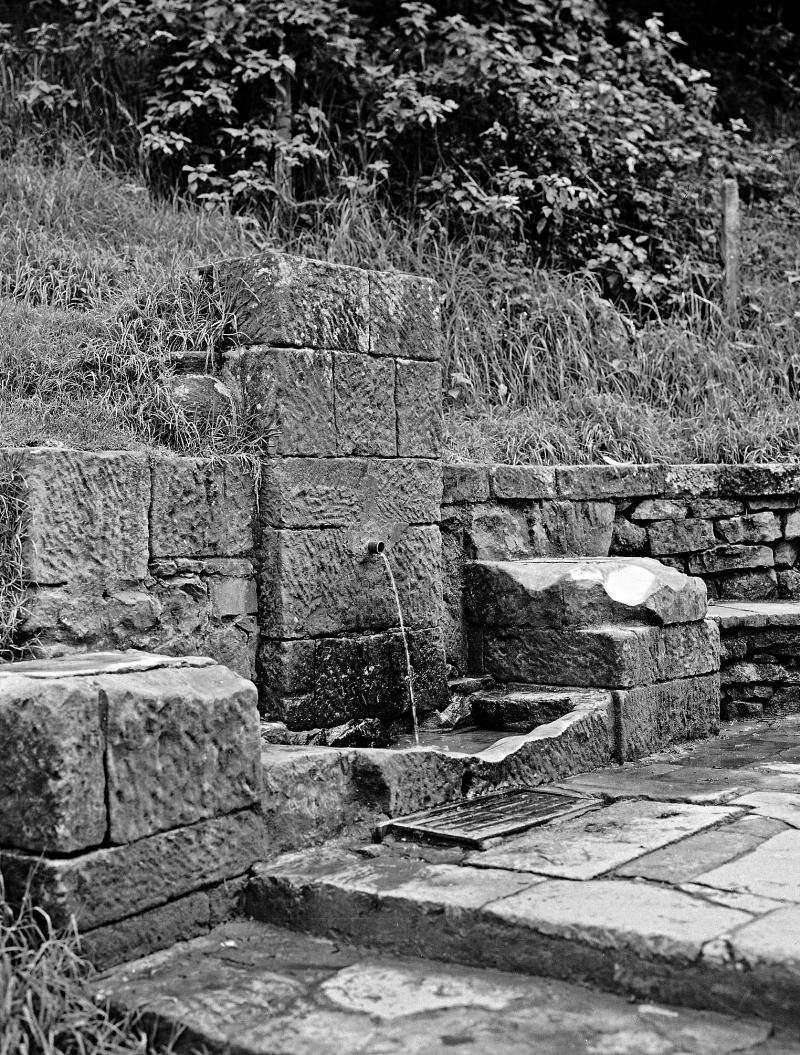
Saúl Ordúz, Chorro de Padilla, 1979
Saúl Ordúz, Chorro de Padilla, 1979
At the beginning of the twentieth century public water fountains were installed across the city to bring free water to citizens. This photograph shows one of them: the Chorro de Padilla, a colonial water fountain that poured freshwater from the mountain of Monserrate, one of the mountains from the Cordillera Oriental near Bogotá.
All rights reserved. Courtesy of Museo de Bogotá. Instituto Distrital de Patrimonio Cultural.
The copyright holder reserves, or holds for their own use, all the rights provided by copyright law, such as distribution, performance, and creation of derivative works.
Throughout the twentieth century, the building of infrastructure for the catchment, storage, and purification of water became material evidence of the relationship that had been established between Bogotá and its surrounding water sources. The scarcity and pollution of the water circulating through the city at the beginning of the century began to concern officials in the municipal administration, who tackled the issue by obtaining and purifying water from nearby rivers. When these rivers were not enough to satisfy the demands placed by the growing urban population, they opted for the exploration of bigger and more distant river basins, after which they began to build dams, reservoirs, and water treatment plants. The 1930s marked the beginning of the golden age of these great infrastructural projects, although the first steps date back to far before this period.
During the initial years of the twentieth-century water in Bogotá was supplied by a private aqueduct administered by the Colombian businessmen Ramón Jimeno and Antonio Martínez de la Cuadra, who in 1886 were given the provision of the service in concession due to the constraints of the municipal administration. The aqueduct was actually a set of unarticulated pipe networks that distributed the water stored in tanks located in the Egipto, San Diego, and Chapinero neighborhoods. The water was obtained from the San Francisco and Arzobispo rivers, as well as from La Vieja and Las Delicias rivulets. The pipes transported the water to houses with domiciliary connections to the aqueduct, but also brought water to free public fountains in plazas around the city. The free supply system also included the famous Chorro de Padilla, a colonial freshwater fountain in the nearby mountain of Monserrate.
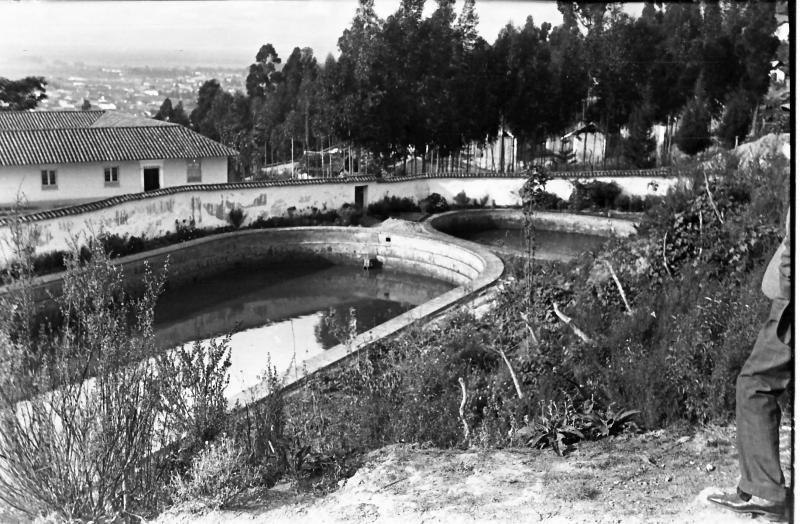
Luis Alberto Acuña, Quinta de Bolívar, 1920
Luis Alberto Acuña, Quinta de Bolívar, 1920
During the early years of the twentieth century, water in Bogotá was supplied by an aqueduct that consisted of a group of complicated pipe networks that distributed the water stored in tanks. This picture shows the storage tanks located in the Egipto neighborhood, on the Cordillera Oriental of Bogotá.
All rights reserved. Courtesy of Museo de Bogotá. Instituto Distrital de Patrimonio Cultural.
The copyright holder reserves, or holds for their own use, all the rights provided by copyright law, such as distribution, performance, and creation of derivative works.
The private aqueduct installed by Jimeno and Martínez substituted ancient colonial stone ditches with iron piping with the expectation of limiting loss and water pollution during distribution. However water quality remained deficient due to the absence of efficient purifying methods. This problem, along with the businessmen’s lack of interest in widening the coverage of the domiciliary aqueduct, set public opinion against private aqueduct management, thus facilitating public debate about what we would now call the “right to water”.
Politicians, journalists, and doctors promoted the initiative to give the municipality responsibility for the aqueduct, arguing as to the necessity of exercising a public government over urban services. After three years of hard negotiation, the aqueduct became municipal in 1914 with the creation of the Municipal Aqueduct Company of Bogotá (Empresa Municipal del Acueducto de Bogotá). This company assumed implementation of the measures needed to solve water’s scarcity and lack of potability.
“But for this water to give to the organism, with benefit, the quantities that perspiration and excretions have evicted from it, it is necessary, in an indispensable way, that the water destined for restoring purposes is potable water. That is, water in which, besides oxygen and hydrogen, which are natural components, there are no other animal substances, vegetable or mineral in excess or over the quantities that are compatible with health, as this would complicate the water’s nature, changing its properties from beneficial to harmful, and making it bad for health. Thence, the quality of water that is used in food preparation has a great influence over health, and consequently over the life of men.”
—Rafael Zerda Bayón. El agua en la salud y el trabajo,13. Bogotá: Casa Editorial Aurora, 1909). Accessed 19 September 2013. (Quotation translated by the authors of the exhibition.)

Saúl Ordúz, Acueducto, 1940
Saúl Ordúz, Acueducto, 1940
A worker of the Municipal Aqueduct Company of Bogotá installing a water meter to allow the company to charge fees according to domiciliary consumption.
All rights reserved. Courtesy of Museo de Bogotá. Instituto Distrital de Patrimonio Cultural.
The copyright holder reserves, or holds for their own use, all the rights provided by copyright law, such as distribution, performance, and creation of derivative works.
Studies from local chemical laboratories, inaugurated in 1906 by Federico Lleras Acosta, indicate how Pasteurian microbiology was adopted in the Colombian scientific practice and prove that the water from the aqueduct did not comply with the minimum requirements of potability. It contained high quantities of ammonia and nitrites—organic substances that increase the proliferation of microbes responsible for waterborne diseases. Under those circumstances, the purification of water through mechanical processes such as decantation and filtration was insufficient, making necessary the implementation of further chemical procedures including the addition of liquid chlorine to the water.
Despite opposition from some inhabitants concerned about the toxicity of chlorine, its addition to water was approved in 1920, as it was considered an efficient and economical measure. Chlorine was initially imported from the United States, but as a result of restrictions imposed on its commercialization during World War II, the national production of chlorine became imperative, leading to the creation of the National Company of Chlorine and Derivatives in 1942 (Compañía Nacional de Cloro y sus Derivados).
“Industrial progressive men, Mr. Posada and Mr. Tobón, have given to their factory of carbonated drinks—which has functioned for some time in this city—a new broadening with the mounting of a department dedicated to water sterilization through UVA rays. This industry, built with modern machinery and in consultation with the best scientific progress, will be of great benefit to Bogotá, where bad potable water quality represents a real danger and has been the cause of violent typhus epidemics.”
—“Progreso de Bogotá—La esterilización de las aguas.” El Gráfico, 15 June 1918, 121. (Quotation translated by the authors of the exhibition.)
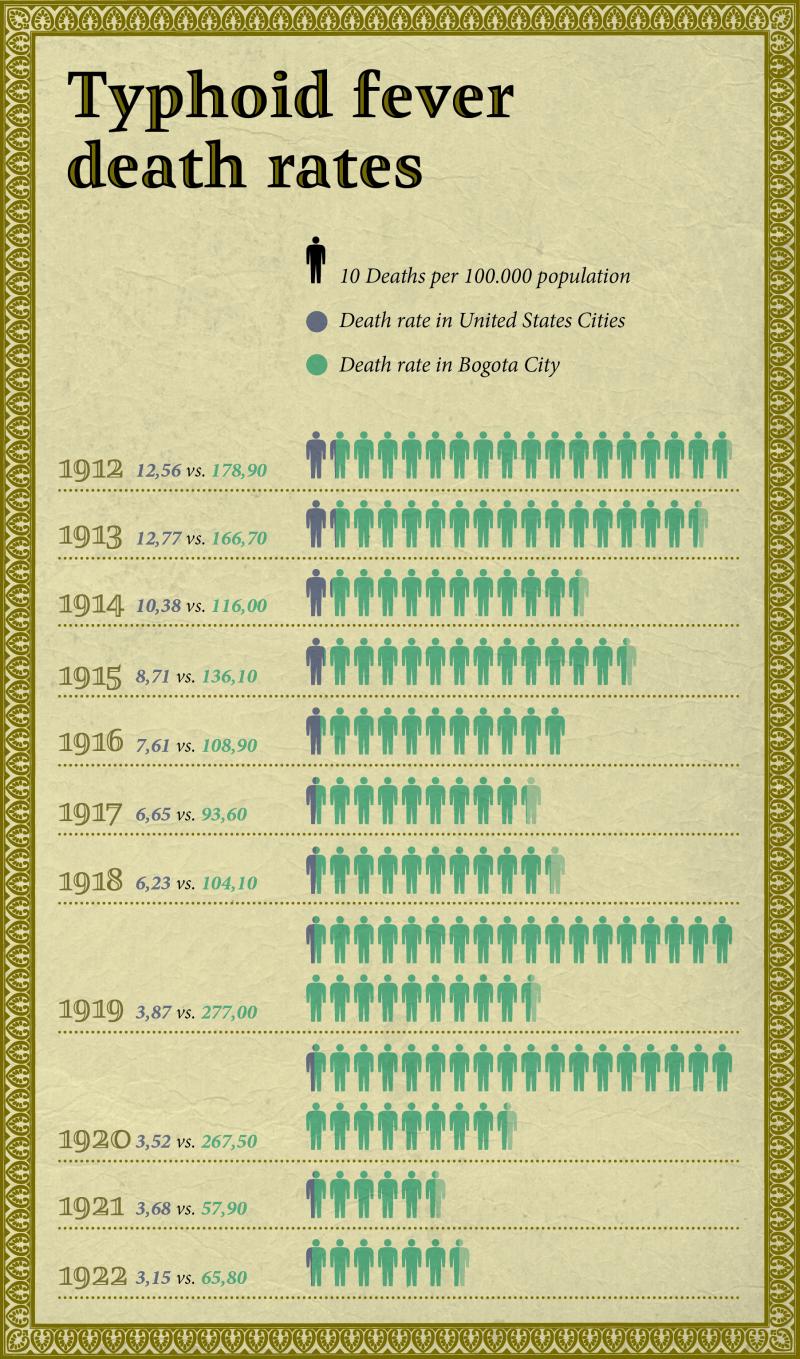
Typhoid fever death rates: A comparison between the United States and Bogotá, 1912-1922
Typhoid fever death rates: A comparison between the United States and Bogotá, 1912-1922
Outbreaks of typhoid fever are related to insufficient hygiene and sanitation infrastructure. Contaminated water, used for irrigation purposes or drinking, is the main cause for the occurrence of typhoid fever epidemics affecting all age groups. Since the supply of drinking water was inadequate in the urban areas in which they settled, the migration of rural people into the city was also a problem. Another epidemiological factor was the weather: in the dry season the accumulation of waste and flies played an important role in the dissemination of the bacillus.
Cristóbal Bernal. “Estadística de mortalidad por enfermedades hídricas en Bogotá, de 1912 a 1922.” Santafé y Bogotá 1. no. 6 (1923): 395–99.
Dabney H. Maury. Estudios sobre el abastecimiento de aguas para la ciudad de Bogotá. Bogotá: Editorial de Cromos, 1929, 17.
Designed by Mónica Páez Pérez and María José Castillo Ortega. Tangrama, 2014.
 This work is licensed under a Creative Commons Attribution-NonCommercial-ShareAlike 3.0 Unported License.
This work is licensed under a Creative Commons Attribution-NonCommercial-ShareAlike 3.0 Unported License.
Another key intervention was the purchase of land at the sources of rivers providing water to the aqueduct. Between 1916 and 1918, the municipal administration bought nearly 4,480 hectares of terrain in the basins of the San Francisco, San Cristóbal, and Arzobispo rivers. Inhabitants of the area were evicted, mining activities restricted, farming prohibited, and reforestation programs developed. These measures mitigated the consequences of pollution in high river basins, which in turn improved water quality. The positive effect on mortality from waterborne diseases was tangible: typhoid fever death rates dropped from 136 deaths per 100,000 inhabitants in 1915 to 58 per 100,000 inhabitants in 1921.
Without waiting for institutional measures, Bogotá’s citizens took action by buying home filters and bottled water. A handful of Colombian companies made these innovations available to an increasingly larger public by advertising their products with reference to scientific backing and hygienic claims. This was the case with the purification filters by Camacho Roldán & Tamayo Company, presented to the local press in 1905 as supported by studies by the French chemist Louis Pasteur. Another case was the crystal water bottle sold in 1913 by the Posada & Tobón Company. A 20 liter demijohn was sold directly at the factory for 5 cents, and home delivered at a cost of 10 cents. The success of Posada & Tobón Company was such that by 1918, it announced the opening of a department exclusively dedicated to water purification by UVA rays. The Posada & Tobón Company—later named Postobón—became the most iconic trademark of bottled beverages in Colombia, which still holds true today.

Daniel Rodríguez, Pileta para el abastecimiento de agua, 1950
Daniel Rodríguez, Pileta para el abastecimiento de agua, 1950
© 1950 Daniel Rodríguez. Courtesy of Museo de Bogotá. Instituto Distrital de Patrimonio Cultural. Collection Daniel Rodríguez. Reference MdB17001.
Woman filling water from public pump.
The copyright holder reserves, or holds for their own use, all the rights provided by copyright law, such as distribution, performance, and creation of derivative works.
“Well-educated people exert special effort to ensure the cleanliness of their water; and a fine person would never misuse the pitchers and jars that contain water for drinking. It is a great offense to use the glass to take liquid from the pitcher, drink directly from the same pitcher, pour leftovers into it, fill the glass too much, and so on.”
—Manuel Antonio Carreño. Manual de urbanidad y buenas maneras para uso de la juventud de ambos sexos; en el cual se encuentran las principales reglas de civilidad y etiqueta que deben observarse en las diversas situaciones sociales; precedido de un breve tratado sobre los deberes morales del hombre, 61. Bogotá: Editorial Voluntad, 1961. First edition: 1871. (Quotation translated by the authors of the exhibition.)
Citizens could also consult recommendations from sanitary reformers on water consumption. In his etiquette handbook, Manuel Antonio Carreño invited his readers to follow basic rules to avoid the pollution of water stored in pitchers. In turn, dissertations written by some physicians and communications from the Directorate for Hygiene and Health of the Bogotá Municipality (Dirección de Higiene y Salubridad del Municipio de Bogotá) recommended boiling water, and washing fruits, raw vegetables and dinnerware with this sanitary water only.
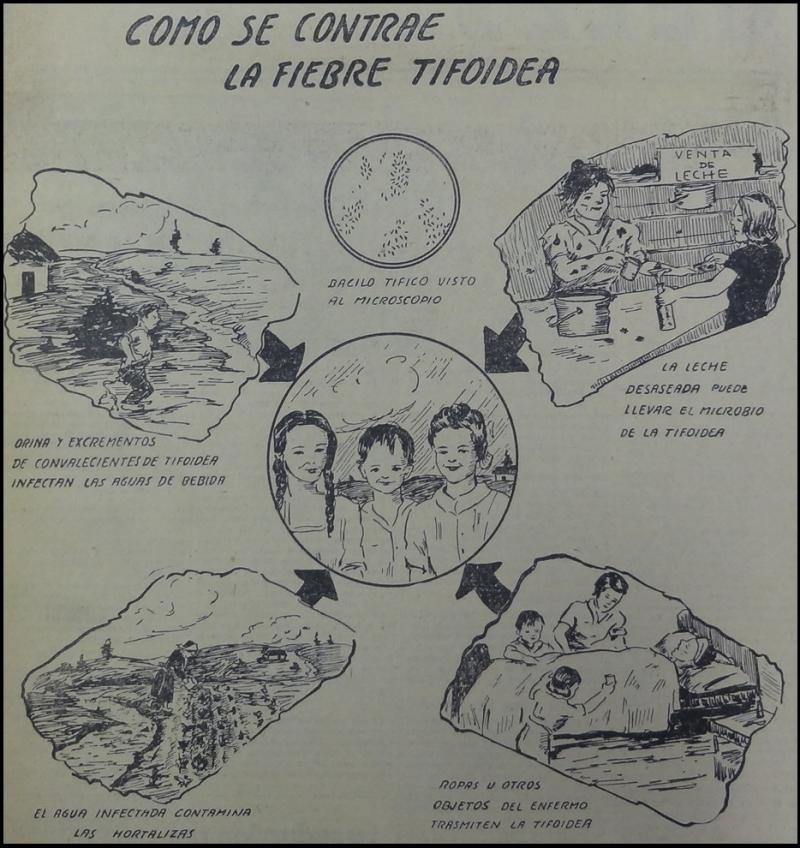
“Enfermedades contagiosas: Lo que debe saberse sobre fiebre tifoidea”, El Tiempo, 1946
“Enfermedades contagiosas: Lo que debe saberse sobre fiebre tifoidea”, El Tiempo, 1946
Illustration for a newspaper article entitled Contagious diseases: What one should know about typhoid fever, written by the Inter-American Cooperative Service of Public Health in 1946. This illustration depicts persistent means of the spread of typhoid fever: drinking water polluted with excrement containing the bacillus, watering vegetables with contaminated water, drinking unhealthy milk, or contact with the clothes of those infected.
All rights reserved. Courtesy of El Tiempo Casa Editorial.
The copyright holder reserves, or holds for their own use, all the rights provided by copyright law, such as distribution, performance, and creation of derivative works.
The prevention of typhoid fever—a waterborne disease caused by the presence of Eberth bacillus in water contaminated with the feces of infected persons—required additional measures to control different forms of contagion. It was advised to boil not only water for human consumption, but also milk from animals grazing in the west of the city where water for cows and for cleaning milk cans was scarce. Citizens were advised to avoid disposing of excrement in rivers and sewers, not to wash clothes with dirty water, and not to accumulate garbage inside houses since this facilitated the reproduction of the housefly, which could transport on its legs traces of feces contaminated with the bacillus.
Water’s continuous scarcity was also problematic: demand for timber and construction materials had resulted in deforestation and erosion of the Eastern Mountains, thus reducing the soil’s capability to retain the rainwater that replenished the rivers and rivulets flowing down the hills and overall altering the hydrological cycle of the complex ecology of the Bogotá high plateau. Water became increasingly scarce as the population started to increase.
In response, one of the first tasks undertaken by the recently created Municipal Aqueduct Company of Bogotá during the 1920s was the retrieval of water from the San Cristóbal River, which descended through the slopes of the Eastern Mountains before meandering through the city’s southern periphery. Water from the river was seen as the solution to the reduction of the flow from the San Francisco, San Agustín, and Arzobispo rivers, which were the traditional sources of water to the city. The works included the construction of a water intake, the adaptation of two decanters to separate water sediments, the installation of a machine to pour chlorine, and the creation of a storage tank of 3,800 cubic meters’ capacity. New piping was also installed to match the design of a unified network of water distribution. In 1927, Bogotá’s aqueduct had a network of 65,603 meters, although the number of registered clients to the service was barely 5.8 percent of the urban population at an estimated 224,127 inhabitants.

Fondo de Atención y Prevención de Emergencias, “Información Embalse del Neusa”, Sistema de Información para la Gestión de Riesgos y Atención de Emergencias de Bogotá SIRE. Accessed 23 November 2013.
Fondo de Atención y Prevención de Emergencias,
“Información Embalse del Sisga”, Sistema de Información para la Gestión de Riesgos y Atención de Emergencias de Bogotá SIRE. Accessed 23 November 2013.
Juan Camilo Rodríguez Gómez. El agua en la historia de Bogotá. Volume II: 1938–1985. Bogotá: Villegas Editores, 2003, 45, 50, 103, 104, 119, 219, 222, 241.
“CC-BY-NC-SA 3.0 Unported License.” Mónica Páez Pérez and María José Castillo Ortega. Tangrama, 2014.
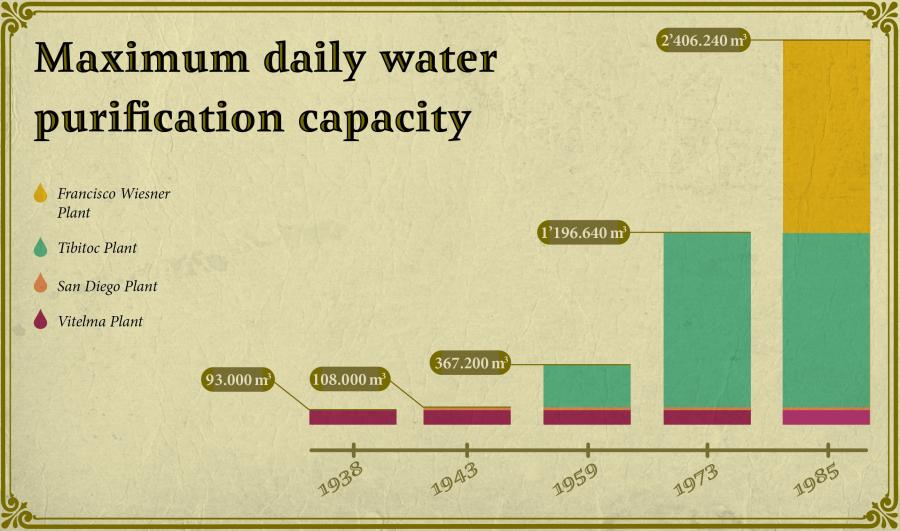
Juan Camilo Rodríguez Gómez. El Agua en la Historia de Bogotá. Volume II: 1938–1985. Bogotá: Villegas Editores, 2003, 47, 51, 80, 142, 169–73, 190–95, 225.
“CC-BY-NC-SA 3.0 Unported License.” Mónica Páez Pérez and María José Castillo Ortega. Tangrama, 2014.
 This work is licensed under a Creative Commons Attribution-NonCommercial-ShareAlike 3.0 Unported License.
This work is licensed under a Creative Commons Attribution-NonCommercial-ShareAlike 3.0 Unported License.
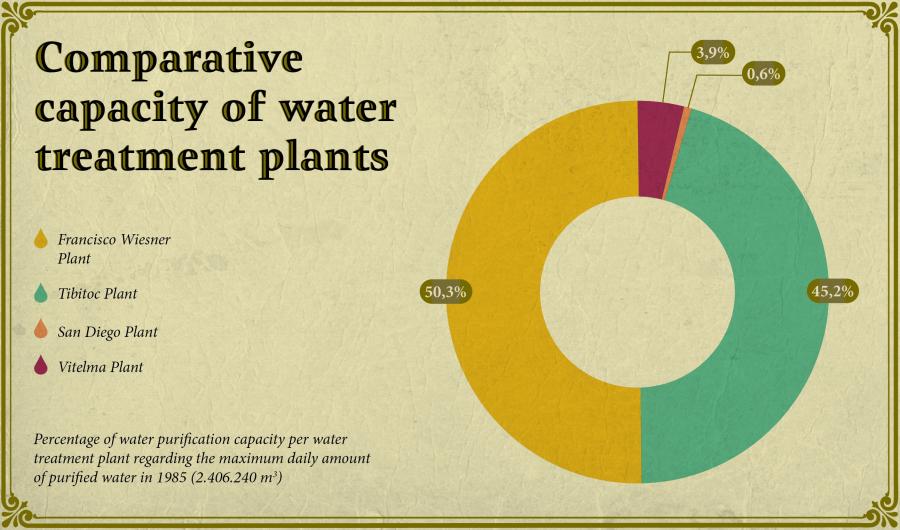
Juan Camilo Rodríguez Gómez. El Agua en la Historia de Bogotá. Volume II: 1938–1985. Bogotá: Villegas Editores, 2003, 47, 51, 80, 142, 169–73, 190–95, 225.
“CC-BY-NC-SA 3.0 Unported License.” Mónica Páez Pérez and María José Castillo Ortega. Tangrama, 2014.
 This work is licensed under a Creative Commons Attribution-NonCommercial-ShareAlike 3.0 Unported License.
This work is licensed under a Creative Commons Attribution-NonCommercial-ShareAlike 3.0 Unported License.
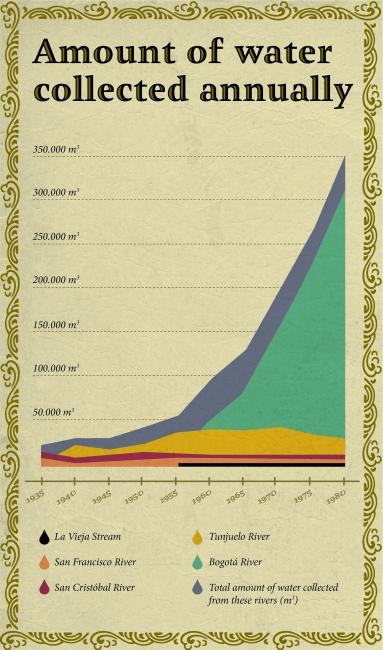
Contraloría Municipal de Bogotá. Anuario municipal de estadística de Bogotá. Bogotá: Contraloría Municipal de Bogotá, 1950, 164.
Departamento Administrativo Nacional de Estadística. Anuario Estadístico de Bogotá. Bogotá: Departamento Administrativo Nacional de Estadística, 1966, 180.
Departamento Administrativo Nacional de Estadística. Anuario Estadístico de Bogotá. Bogotá: Departamento Administrativo Nacional de Estadística, 1969, 165.
Departamento Administrativo Nacional de Estadística. Anuario Estadístico de Bogotá. Bogotá: Departamento Administrativo Nacional de Estadística, 1980, 183.
Departamento Administrativo Nacional de Estadística. Anuario Estadístico de Bogotá. Bogotá: Departamento Administrativo Nacional de Estadística, 1983, 141.
“CC-BY-NC-SA 3.0 Unported License.” Mónica Páez Pérez and María José Castillo Ortega. Tangrama, 2014.
 This work is licensed under a Creative Commons Attribution-NonCommercial-ShareAlike 3.0 Unported License.
This work is licensed under a Creative Commons Attribution-NonCommercial-ShareAlike 3.0 Unported License.
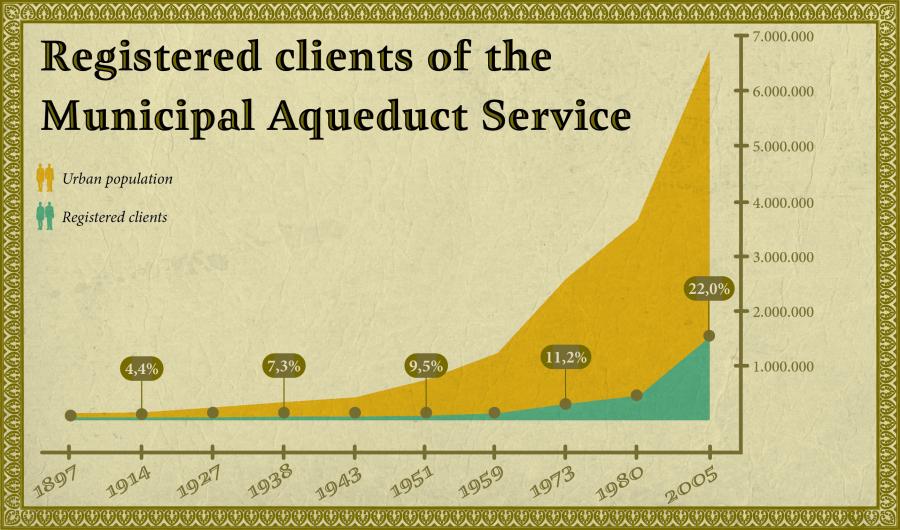
Gratiniano Buitrago Mora. Historia Financiera 1914–1978. Bogotá: Empresa de Acueducto y Alcantarillado de Bogotá, 1978, 187–94.
Contraloría Municipal de Bogotá. Anuario Municipal de Estadística de Bogotá. Bogotá: Contraloría Municipal de Bogotá, 1947.
Contraloría General de la República. Censo General de Población. 5 de Julio de 1938. Ordenado por la Ley 67 de 1917. Departamento de Cundinamarca. Bogotá: Imprenta Nacional, 1941, 9.
Departamento Administrativo Nacional de Estadística. Anuario Estadístico de Bogotá. Bogotá: Departamento Administrativo Nacional de Estadística, 1967, 2. Accessed 15 November 2013.
Departamento Administrativo Nacional de Estadística. Anuario Estadístico de Bogotá. Bogotá: Departamento Administrativo Nacional de Estadística, 1983, 115.
Departamento Administrativo Nacional de Estadística. Características, Planificación y Principales Conceptos del Censo de 1973. Bogotá: Departamento Administrativo Nacional de Estadística, 2009, 80. Accessed 15 November 2013.
Departamento Administrativo Nacional de Estadística. Censo de Población de 1951 (Mayo 9). Departamento de Cundinamarca. Bogotá: Imprenta Nacional, 1954, 12.
Departamento Administrativo Nacional de Estadística. Censo General 2005. Nivel Nacional. Bogotá: Departamento Administrativo Nacional de Estadística, 2008, 35.
Secretaría Distrital de Ambiente. “Número Usuarios con Servicio de Acueducto de EAAB—NUCAA”. Observatorio Ambiental de Bogotá. Accessed 29 November 2013.
Secretaría Distrital de Planeación. Bogotá Ciudad de Estadísticas. Boletín 23. Población y Desarrollo Urbano. Bogotá: Alcaldía Mayor de Bogotá, 2010, 6–15. Accessed 17 November 2013.
Julián Vargas Lesmes, and Fabio Zambrano. “Santa Fe y Bogotá: Evolución Histórica y Servicios Públicos (1600–1957).” In Bogotá 450 Años. Retos y Realidades. Bogotá: Foro Nacional por Colombia—Instituto Francés de Estudios Andinos, 1988, 15, 19, 22, 40.
“CC-BY-NC-SA 3.0 Unported License.” Mónica Páez Pérez and María José Castillo Ortega. Tangrama, 2014.
 This work is licensed under a Creative Commons Attribution-NonCommercial-ShareAlike 3.0 Unported License.
This work is licensed under a Creative Commons Attribution-NonCommercial-ShareAlike 3.0 Unported License.





Dam construction—an important issue in international engineering at the time—was also addressed as a possible solution for the water scarcity problem. Proposals were presented for a dam on the Teusacá, Blanco, Neusa, and Chisacá rivers, but the mighty Tunjuelo River attracted most of the engineers’ attention. A spot called La Regadera—located in the municipality of Usme, southward Bogotá, was chosen for building the dam. The technical challenges of the project raised strong criticism from local civil engineers, despite which the national government and the Bogotá City Council authorized its construction. As a result, in 1933 the city officially entered the “age of dams”.
La Regadera Dam became the main project of the New Aqueduct of Bogotá, inaugurated in 1938 amid enthusiastic celebrations of the fourth centenary of the city’s foundation. The water obtained from the Tunjuelo River was stored in the reservoir formed by the dam, with a capacity of 4,135,000 cubic meters. From there it was conducted through a 22-kilometer pipe of iron and reinforced concrete to the recently inaugurated Vitelma Treatment Plant, where nearly 93,000 cubic meters were purified daily by a process that included aerating the water to eliminate unpleasant smells, using lime and alum to decant impurities, employing sand filters to separate them, and utilizing chlorine against microorganisms. Once purified, the water was channeled through 5,200 meters of piping to the storage tanks located in the Egipto and San Diego neighborhoods, from where it was distributed to a large share of the city.

Saúl Ordúz, Tanques de Vitelma, 1981
Saúl Ordúz, Tanques de Vitelma, 1981
Storage tanks of the Vitelma Treatment Plant located in the San Cristóbal neighborhood, inaugurated in 1938 as part of the New Aqueduct of Bogotá.
All rights reserved. Courtesy of Museo de Bogotá. Instituto Distrital de Patrimonio Cultural.
The copyright holder reserves, or holds for their own use, all the rights provided by copyright law, such as distribution, performance, and creation of derivative works.
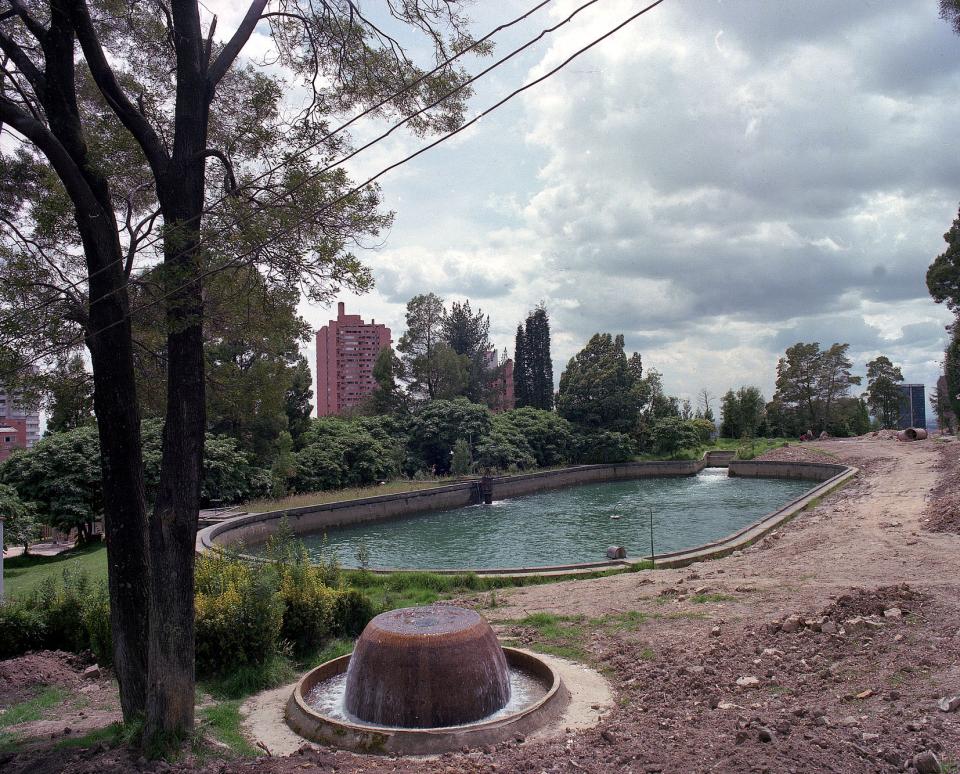
Saúl Ordúz, Tanques de San Diego, 1982
Saúl Ordúz, Tanques de San Diego, 1982
San Diego Treatment Plant, inaugurated in 1943 to purify a daily average of 15,000 cubic meters of water obtained from the San Francisco and Arzobispo rivers. This plant was built to supplement the Vitelma Treatment Plant.
All rights reserved. Courtesy of Museo de Bogotá. Instituto Distrital de Patrimonio Cultural.
The copyright holder reserves, or holds for their own use, all the rights provided by copyright law, such as distribution, performance, and creation of derivative works.
La Regadera Dam was not only a major engineering project at a never-before-seen scale for the area that opened the doors to technological transfers coming from the United States; it also meant the incorporation of the Tunjuelo River basin into urban dynamics. From now on, the Tunjuelo River basin would become an important source of water supply for Bogotá and a terrain for unplanned settlement of new neighborhoods and industries that would increase the pollution of its water, and would condition its course. The river would respond to this with continuous and dangerous overflows and inundations during the heavy rainfall seasons, which are still happening today in spite of municipal interventions into sewerage, channeling, and levees. These levees—made of soil and built on the riverbanks—have proved ineffective with overflows but instead have led to a larger environmental problem: vegetation removal from the riverbanks and the increased sedimentation of water. This has worsened the floods in southern districts of Bogotá, such as Tunjuelito and Bosa.
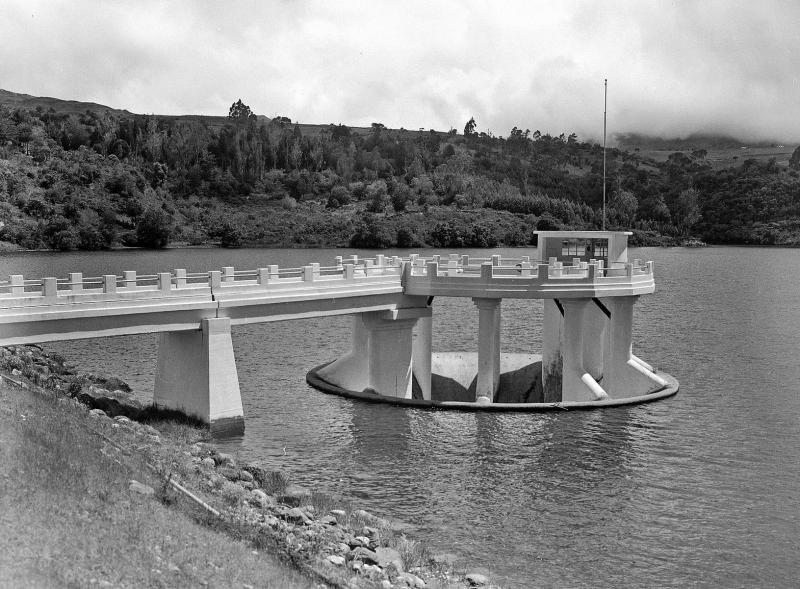
Saúl Ordúz, La Regadera, 1978
Saúl Ordúz, La Regadera, 1978
This is the Glory Hole of La Regadera Dam, built between 1933 and 1938 in order to increment the quantity of water supplied by the aqueduct of Bogotá for the increasing numbers of citizens. The Glory Hole, also called Morning Glory, is a spillway designed in the shape of an inverted bell to release reservoir overflows.
All rights reserved. Courtesy of Museo de Bogotá. Instituto Distrital de Patrimonio Cultural.
The copyright holder reserves, or holds for their own use, all the rights provided by copyright law, such as distribution, performance, and creation of derivative works.
To many observers of the time, La Regadera Dam represented a symbol of industrial modernity and the power of controlling nature to the benefit of urban civilization. However the benefit did not last long. Two years after the inauguration of this major work, the city once again felt the threat of water scarcity. The uncontrolled increase in domiciliary connections, in addition to the misuse and waste of water by service users, jeopardized the water supply during months of low rainfall. While rains returned and the dam recovered its water level, immediate measures were adopted such as suspension of the aqueduct service in the evenings and the installation of water meters in each house that enabled the charging of tariffs according to consumption.
More dam construction followed to ensure a water supply to Bogotá. In 1951 the Chisacá Dam was put into service. It was located at a greater height than La Regadera, and allowed storage of almost 5,000,000 cubic meters of water from the Tunjuelo River. At the same time the reservoirs of the Sisga and Neusa rivers were inaugurated, each of them with over 100,000,000 cubic meters of storage capacity. They not only expanded the availability of water sources to the inhabitants of Bogotá but also prompted the exploration of new possibilities to the north of the city, progressively focusing on larger and more distant rivers.
A few years later, in 1959, the Aqueduct of the Bogotá River, which provided 259,200 cubic meters of purified water to the city every day—particularly for the working class neighborhoods of the west—was opened. This aqueduct captured water from the Bogotá River by a dam built downstream of its confluence with the Neusa River, although it also had at its disposal some of the water stored in the Neusa Reservoir. Once captured, the water was settled for two days in an artificial pond and then driven through pressure pumps to the top of the Tibitoc Mountain. At the top of this mountain was a treatment plant where flocculation, filtration, and sterilization processes were combined to produce potable water that was transported by gravity through 38-kilometer piping to Usaquén, a neighborhood situated in northeastern Bogotá.

Saúl Ordúz, Tanques de Tibitó, 1982
Saúl Ordúz, Tanques de Tibitó, 1982
The Tibitoc Treatment Plant, inaugurated in 1959 and broadened in the 1970s, serves as material evidence of the introduction of the Bogotá River upper basin into Bogotá’s water supply system.
All rights reserved. Courtesy of Museo de Bogotá. Instituto Distrital de Patrimonio Cultural.
The copyright holder reserves, or holds for their own use, all the rights provided by copyright law, such as distribution, performance, and creation of derivative works.
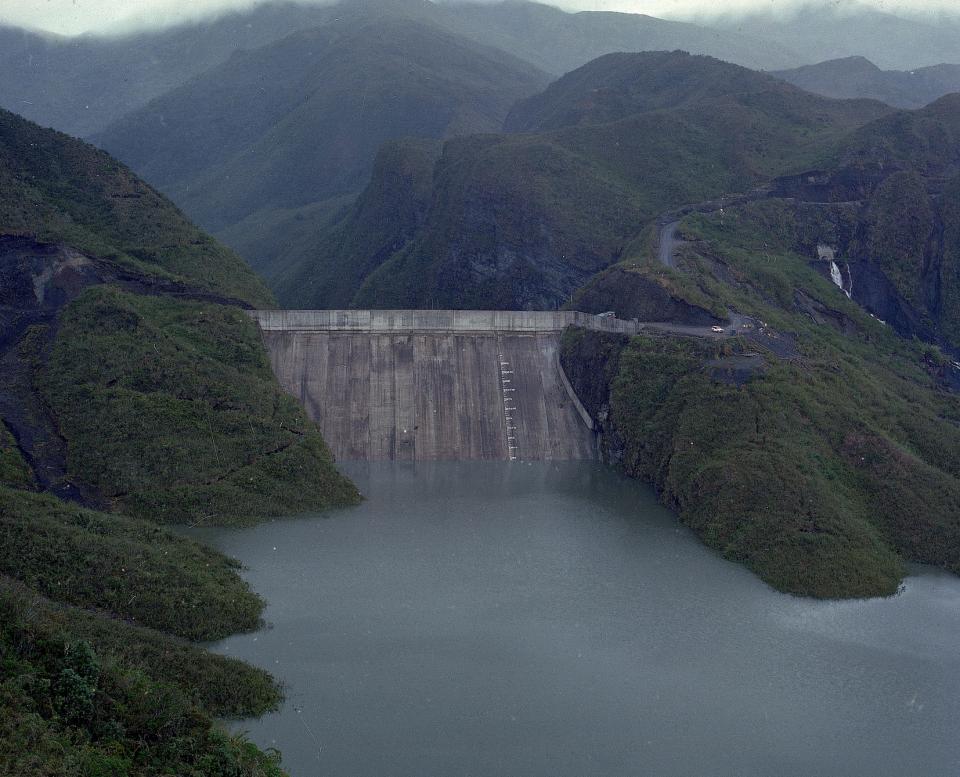
Saúl Ordúz, Visitas Presa de Golillas, 1982
Saúl Ordúz, Visitas Presa de Golillas, 1982
© 1982 Saúl Ordúz. Courtesy of Museo de Bogotá. Instituto Distrital de Patrimonio Cultural. Collection Saúl Ordúz, Reference MdB09512
The copyright holder reserves, or holds for their own use, all the rights provided by copyright law, such as distribution, performance, and creation of derivative works.
Meanwhile, population started growing dramatically. In order to increase the efficiency of the Bogotá River aqueduct, an additional reservoir was built in the Teusacá River, a tributary of the Bogotá River. New pumping stations, sedimentation tanks, and filters of anthracite were installed in the Tibitoc Treatment Plant. An additional water driving system was built between Tibitoc and Bogotá, and new water mains for distribution were also installed within the city. By 1973—the year these works were finished—the aqueduct of the Bogotá River had increased its capacity to 1,088,640 cubic meters of drinking water per day.
The broadening of the aqueduct of the Bogotá River meant the introduction of a water governance that focused on long-term actions, because sustained demographic growth rendered shorter-term engineering interventions useless. Following this logic, the Aqueduct and Sewerage Company of Bogotá (Empresa de Acueducto y Alcantarillado de Bogotá) turned its attention to the Chingaza Páramo. A major project for a new dam, a reservoir, and pipelines began construction in 1972 and, with the expectation that it would provide water until 2020, became the largest infrastructure project in the history of water supply for Bogotá in the twentieth century.
The Chingaza Páramo project consisted of the deviation of the Chuza, Guatiquía, and Frío rivers towards Bogotá and therefore turned them into new tributaries of the basin of the Bogotá River at the western limits of the city’s expansion area. Construction works included the Golillas Dam, which made possible the creation of the Chuza Reservoir, with a storage capacity of 250,000,000 cubic meters of water from the Chuza and Guatiquía Rivers and from other minor sources such as the Golillas and Leticia rivulets. The stored water was transported to the city through a conduction system of over 37 kilometers that ended in the Francisco Wiesner Treatment Plant, where up to 1,209,600 cubic meters underwent purification per day.
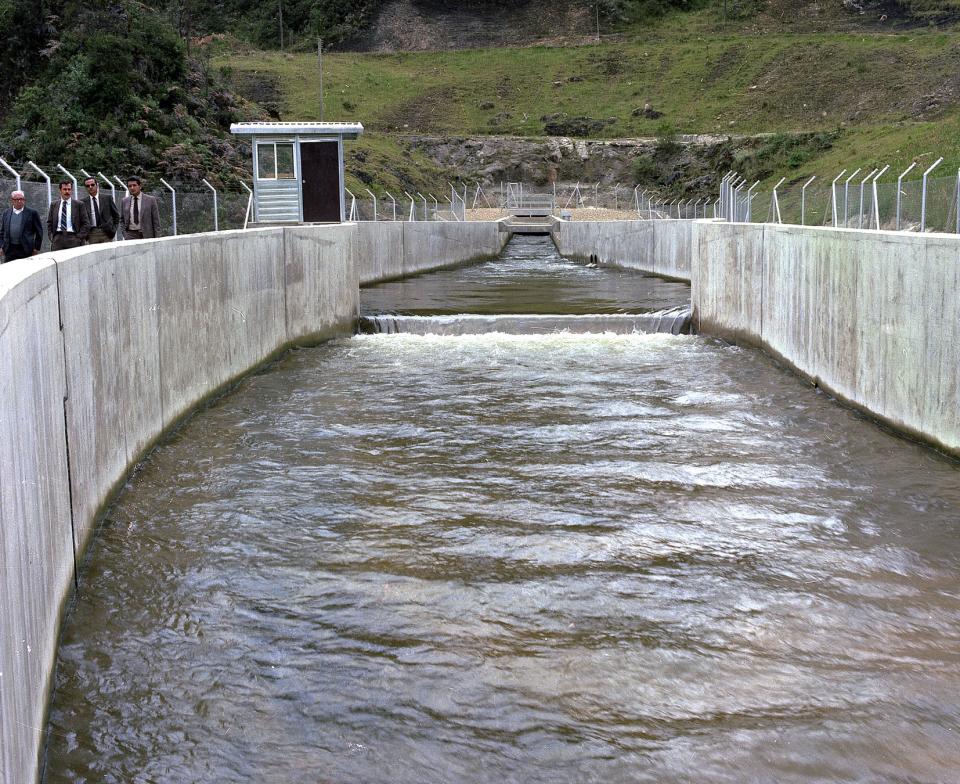
Saúl Ordúz, Canal salida Simayá Plan Chingaza, 1982
Saúl Ordúz, Canal salida Simayá Plan Chingaza, 1982
The Simayá Channel formed part of a water conduction system of over 37 kilometers that ran from the Chuza Reservoir to the Francisco Wiesner Treatment Plant, both large-infrastructure interventions incorporated into the Chingaza Páramo project.
All rights reserved. Courtesy of Museo de Bogotá. Instituto Distrital de Patrimonio Cultural.
The copyright holder reserves, or holds for their own use, all the rights provided by copyright law, such as distribution, performance, and creation of derivative works.
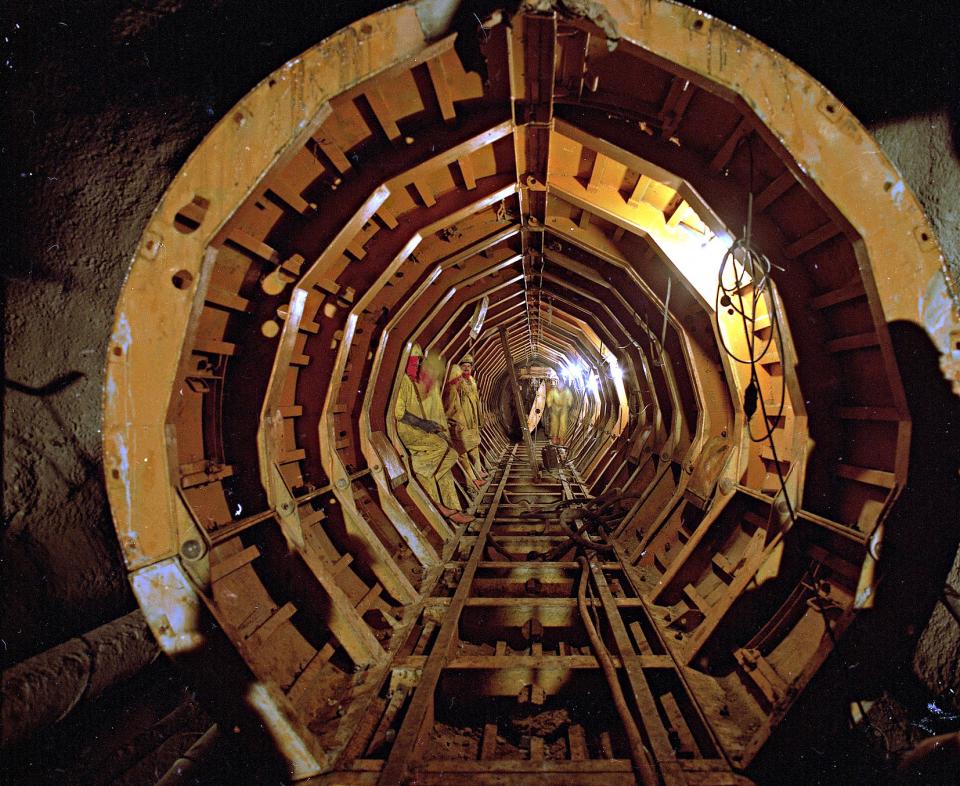
Saúl Ordúz, Túnel de Ventana, 1983
Saúl Ordúz, Túnel de Ventana, 1983
All rights reserved. Photographed by: Ordúz, Saúl (1983)., Túnel de Ventana. Courtesy of Museo de Bogotá. Instituto Distrital de Patrimonio Cultural.
The copyright holder reserves, or holds for their own use, all the rights provided by copyright law, such as distribution, performance, and creation of derivative works.
“The other water source in the neighborhood, the one that always waited at the street corner, the diva, the manager of life, was the water fountain. Synonymous to cooking, cleaning and, of course, as it has to be with desired and scarce things, the cause of conflicts. A stream, a single stream of water comes from the fountain for the whole neighborhood. My dad, José de Jesús, my uncles, Elías, Evangelista and Ismael, all of them with prophetic and biblical but not miraculous names, as any Christian, if you will forgive the repetition, had to fall in line with a pot in hand to receive their fill of the indispensable water”.
—Natalia García Mora. “La Pila”. In Talleres de Crónica: Memorias del Agua en Bogotá: Antología, edited by Maryluz Vallejo Mejía, 50. Bogotá: Banco de la República, Pontificia Universidad Javeriana, Alcaldía Mayor de Bogotá, Archivo de Bogotá, 2011. Accessed 14 August 2013. (Quotation translated by the authors of the exhibition.)
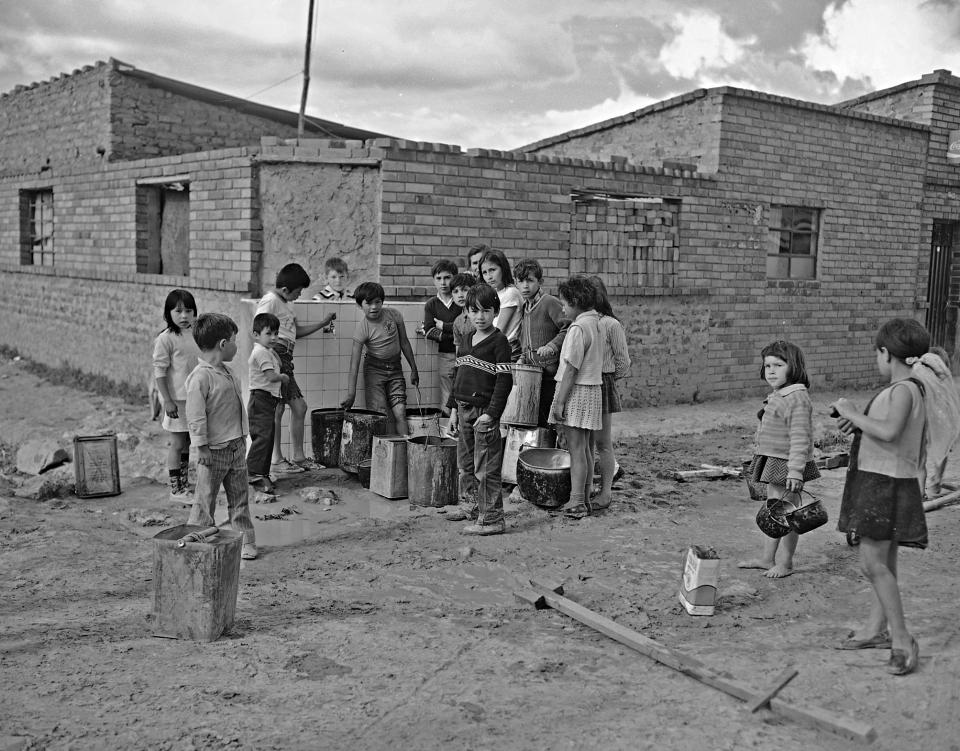
Saúl Ordúz, Acueducto comunal de Suba, 1972
Saúl Ordúz, Acueducto comunal de Suba, 1972
A group of children waiting in line to fill their buckets, cans and pots with water from a public fountain in a poor neighborhood in the Suba district, northwest of Bogotá. The situation captured in this photograph shows not only the socially differentiated relationship between population and water that has characterized the history of the city, but also the active role of children in daily domestic dynamics related to water supply.
All rights reserved. Courtesy of Museo de Bogotá. Instituto Distrital de Patrimonio Cultural.
The copyright holder reserves, or holds for their own use, all the rights provided by copyright law, such as distribution, performance, and creation of derivative works.
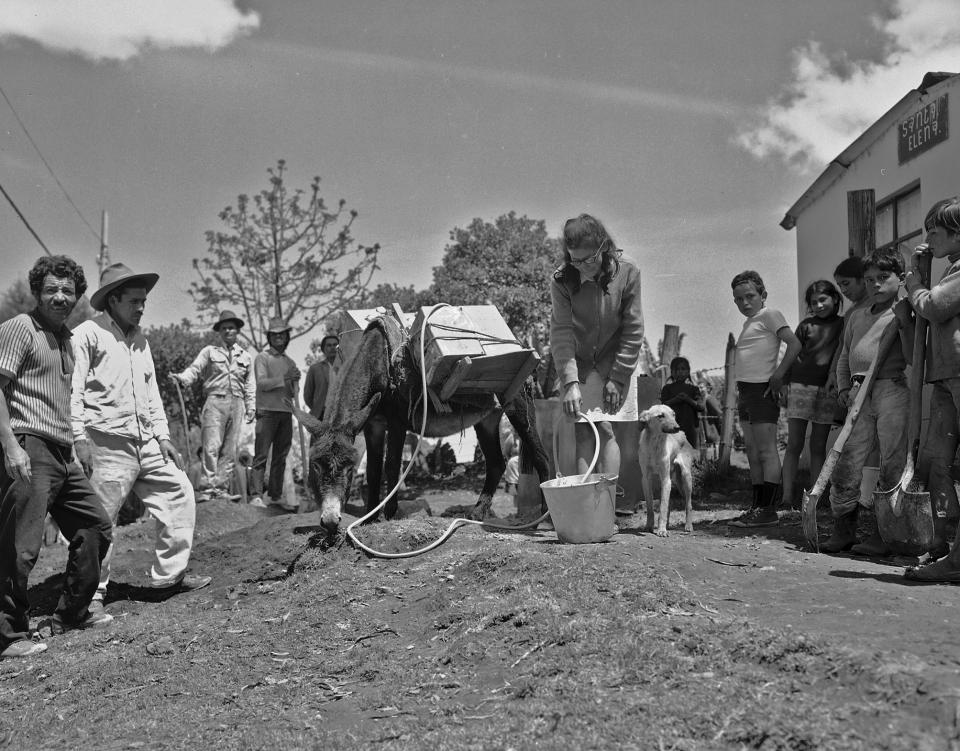
Saúl Ordúz, Acueducto comunal de Suba, 1972
Saúl Ordúz, Acueducto comunal de Suba, 1972
Woman filling a bucket with water from cans that are transported by a donkey to a poor neighborhood located in the Suba district, northwest of Bogotá.
All rights reserved. Courtesy of Museo de Bogotá. Instituto Distrital de Patrimonio Cultural.
The copyright holder reserves, or holds for their own use, all the rights provided by copyright law, such as distribution, performance, and creation of derivative works.
The project experienced many technical and financial difficulties, but was finally concluded in 1985. Nevertheless the project failed to ensure the end of Bogotá’s water supply problems: the domiciliary service of the aqueduct was still absent in poor peripheral neighborhoods, which continued to grow from the mid-twentieth century onwards and became home to a large number of migrants escaping from armed conflict in the countryside. These impoverished neighborhoods faced water rationing that forced them to use alternative methods to acquire and transport water. Between these methods were the water tankers that sold the liquid, the loyal donkeys, transporters of the water, and the popular morning races of children to the closest public water fountain where crowds waited in line to fill their buckets, cans, and pots with water to satisfy their necessities.

Saúl Ordúz, Trabajo Acueducto Barrio Nueva Caledonia, 1980
Saúl Ordúz, Trabajo Acueducto Barrio Nueva Caledonia, 1980
Man filling a receptacle with water poured from the faucet of a public water fountain in the Nueva Caledonia neighborhood.
All rights reserved. Courtesy of Museo de Bogotá. Instituto Distrital de Patrimonio Cultural.
The copyright holder reserves, or holds for their own use, all the rights provided by copyright law, such as distribution, performance, and creation of derivative works.
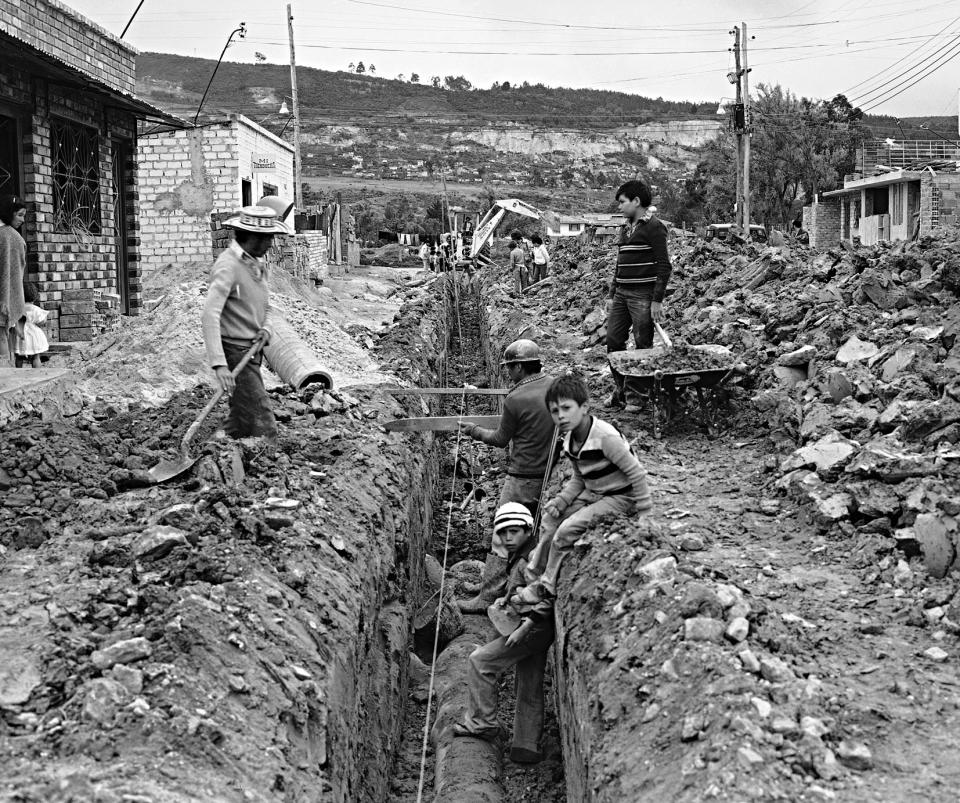
Saúl Ordúz, Trabajos Acueducto Barrio Verbenal, 1980
Saúl Ordúz, Trabajos Acueducto Barrio Verbenal, 1980
Men and boys installing underground piping for the aqueduct of the Verbenal neighborhood, a poor area located in the northeast of Bogotá. The financial inability of the city’s government to solve the urgent needs of emerging neighborhoods led many people to develop material improvements on their own.
All rights reserved. Courtesy of Museo de Bogotá. Instituto Distrital de Patrimonio Cultural.
The copyright holder reserves, or holds for their own use, all the rights provided by copyright law, such as distribution, performance, and creation of derivative works.
The absence of an aqueduct service in peripheral neighborhoods symbolized the socially-differentiated relationship between water and population. Aware of the social fragmentation linked to water supply, the Aqueduct and Sewerage Company of Bogotá turned from the technical complexity of the dams and the enormity of the reservoirs to constructing storage tanks, pumping stations, and piping networks in low-income neighborhoods shortly after completion of the Chingaza Páramo project. From now on, the Aqueduct and Sewerage Company of Bogotá gave more attention to the neighborhood-level interventions that were essential for solving the absence of aqueduct services in a substantial part of the city.
The original virtual exhibition includes an embedded video featuring construction of the New aqueduct of Bogotá. View the film here (https://vimeo.com/73661768).
Construction of the New Aqueduct of Bogotá from Línea de Historia Ambiental on Vimeo.
Selected fragments of an original silent video showing the construction of La Regadera Dam and the Vitelma Treatment Plant between 1934 and 1938. Thanks to funding from the Ministry of Public Works, the filmmakers Acevedo e Hijos attained a detailed visual record of the phases of construction of these two works that formed part of the New Aqueduct of Bogotá. The video reveals the technological advances used in the project, its magnitude, and its impact on nature. The background music was composed and recorded by Arlington Vaca, author of an original musical composition in the traditional musical genre of pasillo which was very popular in Bogotá in the early twentieth century.
Video: Construcción del Nuevo Acueducto de Bogotá, DVD, directed by Acevedo e Hijos (Bogotá: Acevedo e Hijos, 1934–1938).
Bogotá, Fundación Patrimonio Fílmico Colombiano, Code DVD0005-5997. All rights reserved. Courtesy of Fundación Patrimonio Fílmico Colombiano.
Authorization for use of images No. 782.
Music: Arlington Vaca, Añoranza, 2013, MP3 file. All rights reserved. Courtesy of Arlington Vaca.
Construction of the New Aqueduct of Bogotá from Línea de Historia Ambiental on Vimeo.
Selected fragments of an original silent video showing the construction of La Regadera Dam and the Vitelma Treatment Plant between 1934 and 1938. Thanks to funding from the Ministry of Public Works, the filmmakers Acevedo e Hijos attained a detailed visual record of the phases of construction of these two works that formed part of the New Aqueduct of Bogotá. The video reveals the technological advances used in the project, its magnitude, and its impact on nature. The background music was composed and recorded by Arlington Vaca, author of an original musical composition in the traditional musical genre of pasillo which was very popular in Bogotá in the early twentieth century.
Video: Construcción del Nuevo Acueducto de Bogotá, DVD, directed by Acevedo e Hijos (Bogotá: Acevedo e Hijos, 1934–1938).
Bogotá, Fundación Patrimonio Fílmico Colombiano, Code DVD0005-5997. All rights reserved. Courtesy of Fundación Patrimonio Fílmico Colombiano.
Authorization for use of images No. 782.
Music: Arlington Vaca, Añoranza, 2013, MP3 file. All rights reserved. Courtesy of Arlington Vaca.







